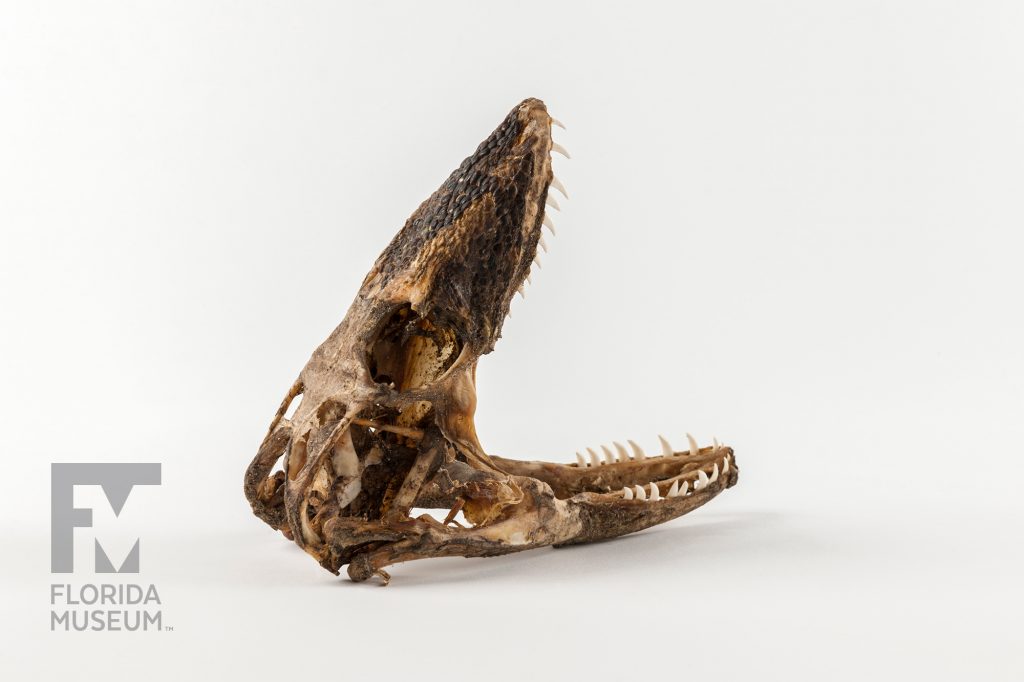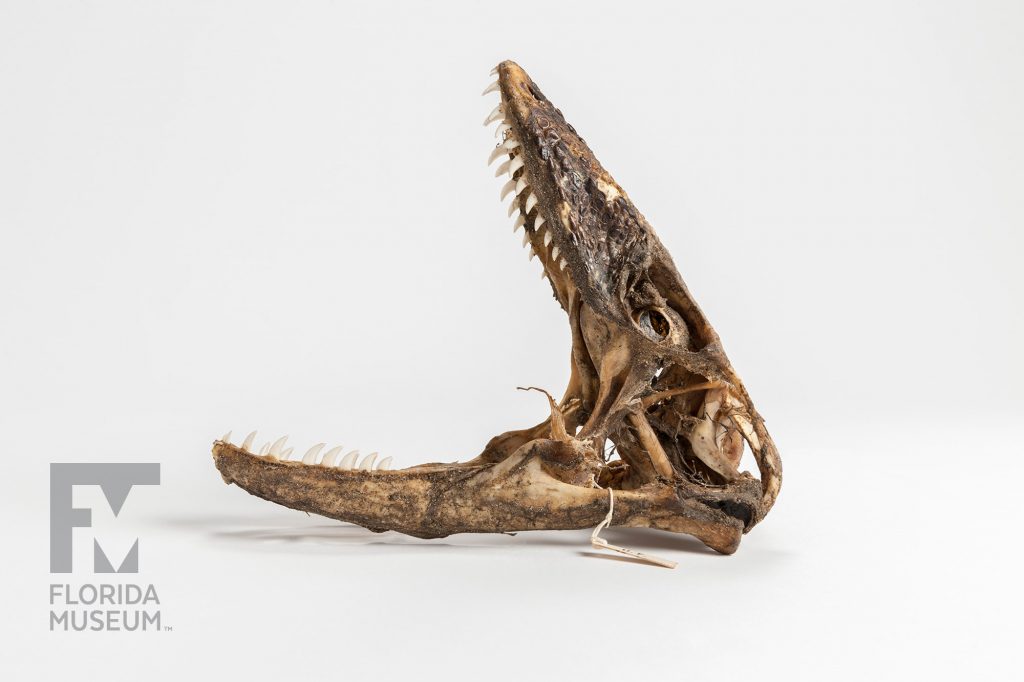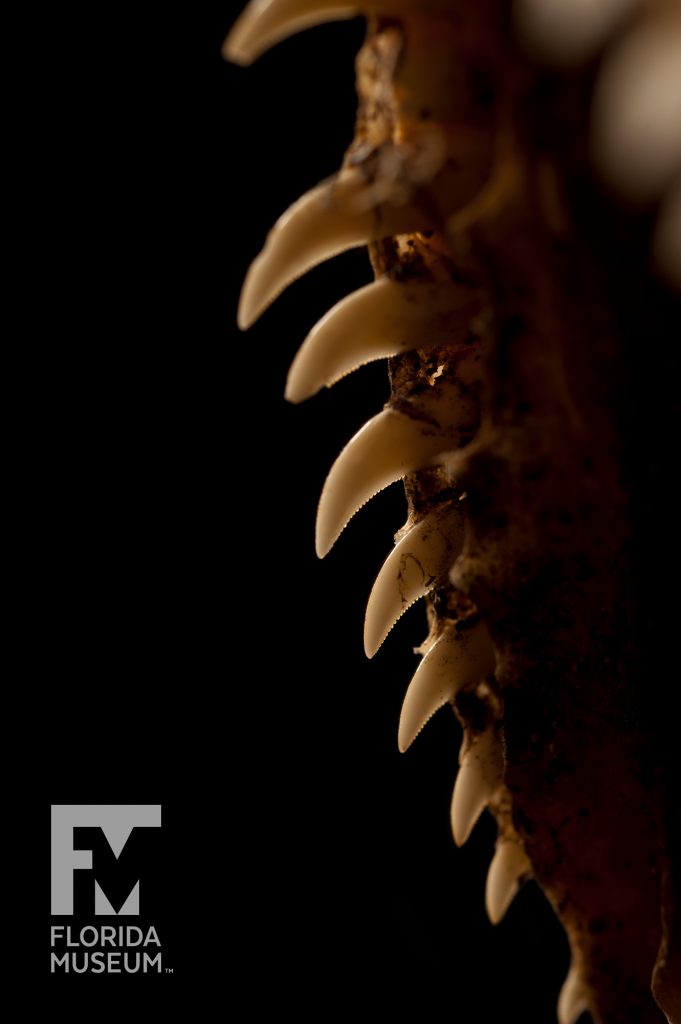The Komodo Dragon grows up to 10 feet long – the world’s largest living lizard. In the late 1960s, research on its ecology by Curator Walter Auffenberg laid the groundwork for today’s conservation initiatives of this unique and threatened species.
Summary
Komodo Dragon Skull (Varanus komodoensis)
From Komodo, Indonesia, Apr. 1970
Collection
Story
In 1968 Wayne King from the New York Zoological Society contacted my father, Walter Auffenberg, to find two graduate students to conduct a long-term research program on the island of Komodo, which had never been done before. And my father wrote back and said “Well, two graduate students probably wouldn’t work very well together for very long — they’d be living on the other side the island in a matter of months.” And he suggested that a family would be much more appropriate and be more successful. He obviously had something in his mind because several weeks later we were told at the dinner table that we were going to Komodo to conduct a year-long study of the dragon. Our family at that time included my father and my mother, Elinor, and two younger brothers Garth and Troy, and my older brother stayed here to continue going to the University of Florida.
So we met our father in Jakarta, Indonesia, in August of 1969. From there we went to Surabaya and then on a ship all the way to Komodo. We spent the next 11 months on the island Komodo. We were the only English-speaking people within hundreds of miles…there was no medical clinic, we did not have a two-way radio…it was much different than it is today. The purpose of the expedition was to learn as much as we could about the Komodo Dragon in the time that we had and my father developed a priority list of things to do including feeding strategy, activity patterns, etc. and he was very successful in gathering all that data. Eventually in 1981 producing the pivotal book on the species, “Behavioral Ecology of the Komodo Dragon.”
Komodo dragons get to be about 10 feet long and are well-known as voracious carnivores and predators and they forage for their food constantly while awake — they are not nocturnal. When they’re young they eat birds and lizards and frogs and insects and when they get older they live almost completely off of pigs and deer. Both of which were introduced over a hundred years ago, which brings to mind what did they eat before that? We still don’t know. Occasionally they prey on people, both tourists as well as native people. This occurs about once a year, once every couple years. We’ve observed them eating live animals and none of them lasted more than 10-15 seconds. They grab them by the neck or their hams and they throw them down and the animal is eviscerated immediately.
There are some new data about Komodo Dragons and all monitor lizards. They have a vestigial venom gland in their jaws and their venom is not like a rattlesnake venom or something like that. It’s an anticoagulant allowing the blood to continue to flow and the Komodo Dragons will track that and of course there’s also a lot of incidences of infection in the animals that they wound and they can track that.
The conservation of the Komodo Dragons is a success story in that they were protected early on by the local folks in Indonesia and then later on by international law. The area is now included in a national park and tourism is doing very well in the area.
My father was an excellent teacher and he guided quite a few graduate students through graduate school, mostly in herpetology, and he also guided me into science. The Komodo trip introduced me to Asia and I decided very quickly that I was not going to study a large predator when I became a scientist — and I didn’t. I chose land snails and spent 36 years here at the Museum, most of that time working on land snails, particularly Asian land snails.
Kurt Auffenberg
Retired, Collection Manager, Malacology*
Retired, Exhibits Operations Coordinator*
Florida Museum of Natural History
Additional Information
Listen to more about Walter Auffenberg’s career, by Kurt Auffenberg:
Exhibit
On display Sept. 23, 2017-Jan. 7, 2018, Rare, Beautiful & Fascinating: 100 Years @FloridaMuseum celebrated the Museum’s rich history. Each Museum collection was asked to contribute its most interesting items and share the stories that make them special. Though the physical exhibit is closed, this companion website remains online, providing an opportunity to experience the Florida Museum’s most treasured specimens.
Exhibit Area: Faces of the Museum
Theme: Dedicated Employees
 Want to see more? Explore more than 300 breathtaking color photos of plants, animals, fossils and cultural heritage materials from the Florida Museum of Natural History’s collections in the award-winning book All Things Beautiful available from the University Press of Florida.
Want to see more? Explore more than 300 breathtaking color photos of plants, animals, fossils and cultural heritage materials from the Florida Museum of Natural History’s collections in the award-winning book All Things Beautiful available from the University Press of Florida.
*This title was accurate at the time the exhibit was on display in 2017. Please visit the collection website to verify current staff and student information.


